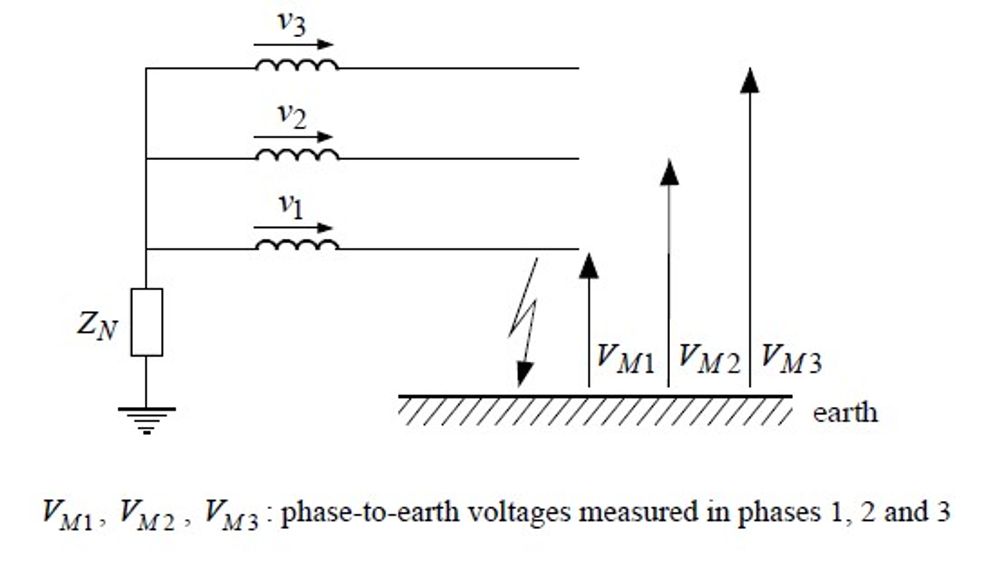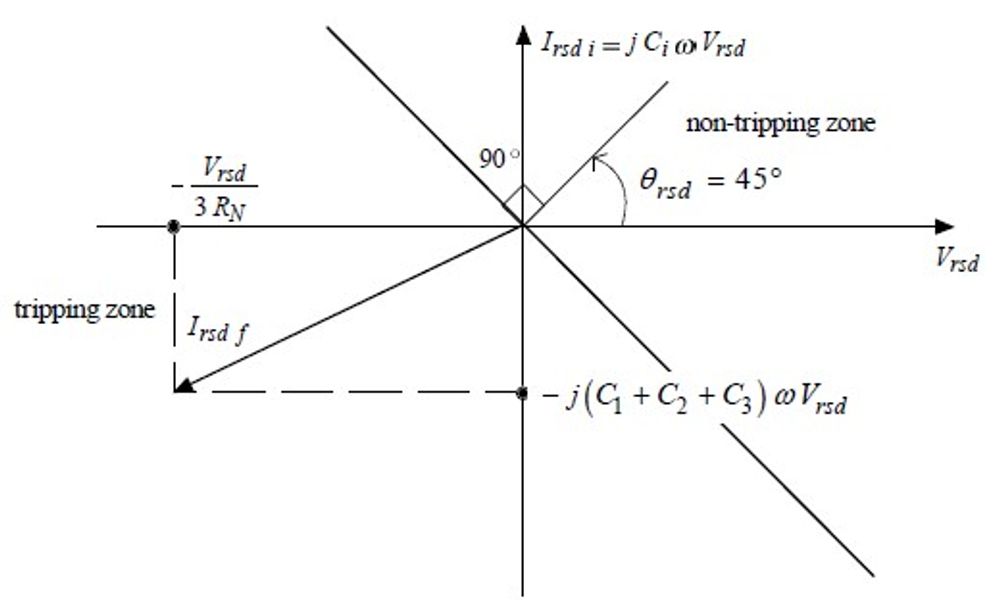Technical Article
Updated 04/2025
Concept Primer 2: Directional Earth Fault Protection
Explaining the underlying physics of Directional Protection

As the second instalment in our mini-series on Directional Protection, Directional Earth Fault Protection is, in our experience, the second most common form of directional protection deployed in distribution networks, but also provides an added degree of complexity for implementation. While Directional Earth Fault also uses the concept of a Relay Characteristic Angle to determine direction, it looks at a different vector value to conventional overcurrent: The Zero Sequence Component. In this article, we explain some of the concepts behind directional Earth Fault, sharing our experience to support field deployment of this valuable protection element.
For those who missed our first article, distributed Generation around the world is an emerging technological trend, which poses a new set of challenges for the energy industry. With the real possibility of bi-directional power flow and the erosion of the conventional Generation, Transmission, Distribution, Retail sequence, the inevitable outcome is that distribution networks need to handle network protection in both a forward and reverse power flow scenario.
“Earth fault protection in general becomes more complicated on isolated or compensated neutral networks,” says NOJA Power Group Managing Director Neil O’Sullivan. “Earth fault current can be capacitively coupled to adjacent feeders and flow backward towards the substation bus causing false protection operations. Directional earth fault protection can be effectively used to detect capacitively coupled earth fault current and block protection operation in these circumstances. It is really essential to have directional earth fault protection capability in today’s distribution networks but particularly where isolated or compensated neutral networks are deployed.”
Directional Earth Fault
Like Directional Overcurrent, Directional Earth Fault (DEF) is used to differentiate between different fault types to ensure that co-ordination between protection devices such as distribution circuit breakers and reclosers is maintained. This principle is referred to as “Selectivity” in protection engineering. Earth faults pose an additional degree of complexity, as they don’t immediately follow nameplate value ratings of cables like Overcurrent does, but instead rely on understanding the full current path for the fault. Earth Fault magnitude, and its complexity, can be briefly summarised as:
- The resistive current
- The Capacitive or Reactive component
The key to understanding Directional Earth Fault is to visualise and understand the fault current path, so that protection selectivity can be set appropriately. That is, we trip only on the faults we want to, and set up other circuit breakers to cover the other fault scenarios. We want to avoid “spurious tripping” (tripping when we aren’t supposed to), but must avoid failing to trip on a genuine fault.
Earth faults occur when there is an undesired loss of energy out of the distribution system. A few examples include trees brushing up against powerlines, broken powerlines landing on the ground, or contact with other items or personnel at earth potential. These Single Line to Ground Faults or Double Line to Ground faults can be very serious, as they may involve life coming into contact with powerlines.
When Earth Faults occur, a new “circuit” is completed as the foreign interference creates an earth path. This results in an imbalance in the currents and voltages, and current flows out through the earth fault site, and returns at other points in the network. This is not the same as an overcurrent fault, because overcurrent assumes that only the existing circuit lines (powerlines) are involved, with no energy leaving the system.
In this article, for simplicity, let’s explore 3 different cases. Earth faults are greatly affected by the Earthing practices of the distribution network, and to explain these effects we will look at three cases:
- Solid/Resistance Earthed
- Unearthed Networks
- Compensated Networks
In figure one, a simple Resistance Earthed Network is shown, where a single line to earth fault occurs on a feeder. When drawing the fault circuit, the resistive current flows out through the fault site, then returns through the star point of the upstream transformer. In a resistance earthed or solidly earthed network, this will be the largest component of the fault current is this resistive component.

However, the resistive component isn’t the only fault current path available. Powerlines, a charge carrier, with a dielectric substance (air) between an earth plane (the ground) act as a giant capacitor. The longer the cables, the more capacitance is available. Earth Faults are unique in that the fault current path also includes a capacitive component where the fault current leaves at the fault site, and returns via all the other connected feeders in the reverse direction.
This is a common reason for DEF: How do you distinguish between a genuine downstream earth fault and a reverse capacitive current effect. These reverse capacitive currents are sometimes called “sympathetic” currents, as they are caused by faults on other feeders but still show up as an earth fault on the un-faulted lines. The current path for this can be seen in figure 1, where all the other feeders return capacitive current in the reverse direction.
This brings about the first observation of DEF – depending on the ratio between capacitive and resistive current, we determine what our Relay Characteristic Angle (RCA) or torque angle should be set to.
Like Overcurrent, earth fault protection uses a voltage vector as a reference for angle calculation, except DEF uses the Zero Sequence voltage and angle instead of the positive sequence. Figure 2 shows a simple calculation with a resistive earth on how this is reached.

It is interesting to note that the Zero Sequence voltage angle is 180 degrees out of phase (is a negative value) with the normal condition positive sequence. It is important to understand if the relay in use requires this 180 degree shift.
With this Zero Sequence Voltage vector calculated, all that remains is to calculate the Resistive and Reactive (usually capacitive) fault current. Therefore, the RCA (Relay Characteristic Angle) and tripping zone is likely to be similar to Figure 3, with minimal variation away from a resistive earth fault current being determined as “Forward”.

In Figure 4, we see an unearthed network. Since there is no apparent resistive earth path, this implies that single line to ground faults tend to have low magnitude, but it certainly doesn’t mean that the lines are safe to touch. In an ungrounded network, the fault current is only capacitive, which means that directional earth fault protection must distinguish between the sign of the reactive component. I.E., is the capacitive current flowing forward or reverse?

For this scenario, we use the same principle to calculate the reference voltage. However, for current, there is no resistive component, so the faulted feeder will see the sum of all the capacitive currents, and un-faulted feeders will only see a reverse capacitive current proportional to the feeders’ capacitance.
The last case is the concept of compensated neutral networks. Almost 100 years ago, it was identified that engineers could compensate for capacitive effects by placing an inductor in the earth path of the upstream transformer. If the inductance in the transformer earth matched the capacitance of the network, and there was no resistance fault path, then earth faults would be reduced to almost zero. In practicality, all real-world inductors have some resistance and it is impossible to perfectly match the capacitance, however these devices were quite effective at reducing earth fault magnitude, and many are in service today. These are called “Petersen Coils”.
Modern techniques today include active compensation, devices which deliberately measure and inject compensation of energy to balance the fault and bring the current at the fault site to very low levels. Whilst these are effective, they also reduce earth fault measurability for conventional devices and make protection more challenging. These typically require specialist calculation and are beyond the scope of this article1.
Nonetheless, figure 5 shows an example with a Petersen coil and a parallel resistor in the earth path of the transformer. The Neutral Earth Resistor (NER) allows a clamped resistive earth fault current, which gives protection devices a value on which to act. The earth fault principle is the same, as we sum the resistive and capacitive effects at the fault site, and all un-faulted feeders will only see the capacitive effects proportional to their “X’ value.

In summary:
- Directional Earth Fault protection can be used for grading of non-radial feeders, but are most commonly used on radial networks to differentiate between real downstream faults and sympathetic capacitive currents.
- Sympathetic currents are almost completely capacitive and travel in the reverse direction, so if a protection engineer wishes to prevent tripping on sympathetic currents, they can use directional earth fault protection to act only on downstream faults.
- Depending on earthing scheme, genuine faults vary in their amount of resistive current, but they are the sum of all capacitive currents and the resistive component.
- Setting of directional earth fault torque angle/RCA is based on catching all the downstream earth faults, while ignoring the capacitive effects.
From this, we can also see that the Overcurrent RCA does not necessarily match the Earth Fault RCA. Finally, when it comes to testing Directional Earth Fault, input of voltage imbalance to match the real-world case is necessary, as this provides the reference Zero Sequence Voltage angle to calculate fault direction.
References
Bender, D., Marx, S., ©2013 An Introduction to Symmetrical Components, System Modelling and Fault Calculation, Presented at 30th Annual Hands on Relay School, March 11- 15 2013. Washington State University, Pullman Washington.
Prévé, C., ©2006 ISTE, “Protection of Electrical Networks”, ISBN-13: 978-1-905209-06-4
This content is provided in good faith, and NOJA Power accepts no liability or responsibility for any loss or damages resulting from inaccuracies or omissions in this content. NOJA Power are committed to sharing knowledge and expertise in the energy industry, and would welcome any feedback or corrections regarding this content. Feedback can be directed to NOJA Power at NOJASales@nojapower.com.au
NOJA Power has a subset of functionality for handling Compensated Neutral Networks available in their OSM Recloser product. For more information, contact NOJA Power.
Want to stay up to date with Electrical Distribution Technology?
Join our list for a free weekly technical bulletin, as we share our Global Electrical Engineering experience directly to your inbox.
Subscribe →